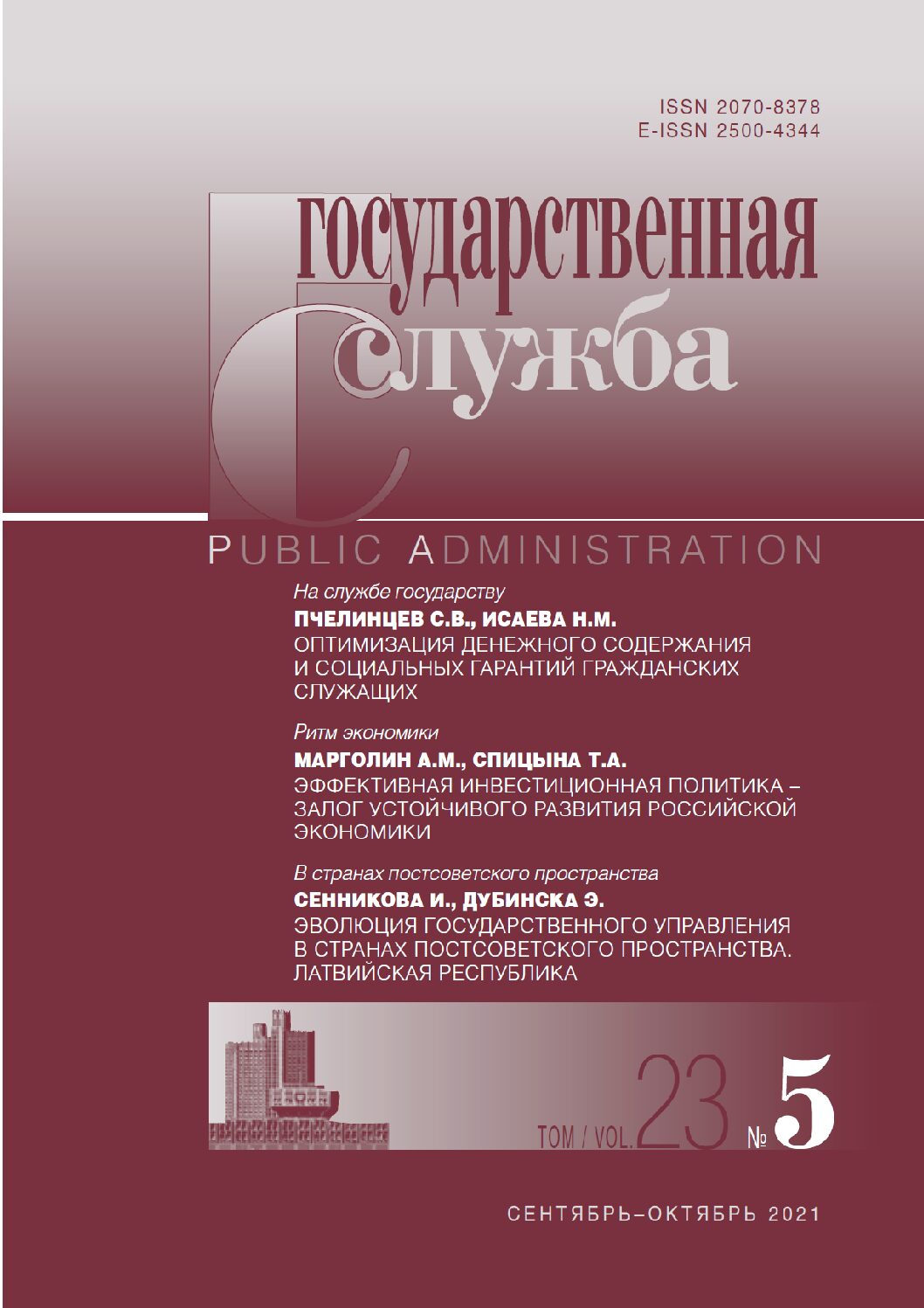Recommended link to article:
OLGA ILINICHNA MOLCHANOVAа
аSaint/Petersburg State University of Economics
DOI: 10.22394/2070-8378-2021-23-5-75-79
Abstract:
The article presents an attempt to operationalize the concept of «managing social interaction in the media space», which is relevant today, but does not yet have a generally accepted interpretation in the scientific world. The specifics of social interaction are primarily represented by the communication component, but are not limited to this factor alone. The procedural nature of social interaction makes it possible to talk about the possibility of managing it, and, therefore, a meaningful approach to regulating communication models in the modern media space. To determine the goals and objectives of the social interaction management system in the media space, it is advisable to use a tiered approach, where the state in the process of managing social interaction in the media space acts as a determining entity, this is a mega-level; at the macro level, this role is performed by the professional community of the mass media; at the micro level, the determining entity is the management of a single editorial office. The individual acts as a defining subject at the micro and macro levels. In this regard, the purpose and objectives of the management system of social interaction processes in the media space can be presented to the relevant determining level. Tasks of the management system of social interaction processes in the media space at the mega-level: development of terminology; introduction of overdue proposals to the Law of the Russian Federation «On Mass Media», official regulation of both innovative processes in the field of media, and relevant changes in secondary and higher professional education for the training of specialists of convergent type editorial offices. It should be borne in mind such a specific characteristic of social interaction as professional convergence, which is an actual trend of the modern media space. The merging of journalism, advertising and PR into a single activity leads to the emergence of many new forms of interaction with the audience, in which the communication aspect comes first. The consumer, having the ability to instantly respond to any information message, becomes a significant actor in the communication process. «Citizen (people’s) journalists», caring people who own communication technologies, expressing their point of view in the public space, contribute to the emergence of a new type of communication activity: attracting famous people as opinion leaders, which actualizes the activity of the audience. The analysis of various points of view made it possible to formulate the term «Management of social interaction in the media space» and identify the key features of the functional of this activity and conclude that further research of this phenomenon is necessary due to the multi-vector nature of its manifestation and the need for a significant update of the foundations of the existing managerial nature.
Keywords:
management, social interaction, media space
Received:
October 10, 2021
References:
Baranova E.A. Formy organizacii i problemy ispol’zovanija UGC na gazetnom sajte. Jelektronnyj nauchnyj zhurnal «Mediaskop». 2014. Vypusk № 2. http://www.mediascope.ru/node/1531
Buzin V.N. Mediaprostranstvo v strukture social’nogo prostranstva. Socium i vlast’. 2012. № 2 (34). P. 12.
Vasilenko L.A. Operezhayushcheye obrazovaniye kak sposob vyzhivaniya chelovechestva. Bezopasnost Evrazii. 2004. № 3 (17). P. 491-505. DOI 10.18411/Vasilenko-1-1.
Vrublevskaja O.A. O sushhnosti ponjatija «social’noe vzaimodejstvie» v nauchnyh issledovanijah. Sibirskij zhurnal nauki i tehnologij. № 5 (12). 2006. P. 60–65.
Gavra D. PR «dvanol’». Korporativnaja imidzhelogija. 2011. URL: http://www.ci-journal.ru/article/596/pr-dvanol
Glushhenko O.A., Grishanin N.V. Jevoljucija special’nosti «Reklama i svjazi s obshhestvennost’ju»: istorija formirovanija, sovremennoe sostojanie i tendencii razvitija. Kommunikologija. 2020. Tom 8, № 1. P. 34−52.
Gromov I.A., Mackevich I.A., Semjonov V.A. Zapadnaja sociologija. SPb.: DNK, 2003. 555 p.
Dugin E.Ja. Metodologija issledovanija media v «jepohu cifrovoj civilizacii». European Journal of Philosophical Research. 2018. № 5 (1). S. 3−18.
Kandaurova A.V. Strategii i urovni social’nogo vzaimodejstvija v pedagogicheskoj dejatel’nosti. Chelovek i obrazovanie. № 4 (37). 2013. P. 85–88.
Kravchenko S.A. Vozrastajushhaja rol’ «cifrovogo tela» v chelovecheskom kapitale: izmenenija v haraktere kommunikacij. Kommunikologija. 2020. T. 8. № 3. P. 22.
Kurbatov V.I. Social’nyj dialog i garmonizacija social’nyh otnoshenij. Social’no-gumanitarnye znanija. 2014. № 12. P. 104.
Molchanova O.I. Ponjatie i sub#ekty sistemy obespechenija upravlenija processami formirovanija konvergentnyh massmedia. Vestnik Povolzhskogo instituta upravlenija. 2017. T. 17. № 4. P. 111–118.
Polonskij A.V. Media i ih tekstovaja real’nost’. Nauchnye vedomosti. Serija «Gumanitarnye nauki». 2015. № 18 (215). Vyp. 27. P. 17–24.
Sociologija. Osnovy obshhej teorii: Uchebnik dlja vuzov / Otv. red. akademik RAN G.V. Osipov, dejstvitel’nyj chlen RAEN L.N. Moskvichev. M.: Norma, 2003.
Timofeeva L.N. Politicheskaja kommunikativistika: teorija, metodologija i praktika. M.: ROSSPJeN, 2012.
Frolov S.S. Sociologija: Uchebnik dlja vysshih uchebnyh zavedenij. M. 1994.
Sharkov F.I. Kommunikologija: sociologija massovoj kommunikacii: Uchebnoe posobie / Sharkov F.I. M.: Izdatel’sko-torgovaja korporacija «Dashkov i K°», 2010.
Sharkov F.I. Osnovy teorii kommunikacii. URL: https://iub.at.ua/_ ld/0/61_.__.pdf
Shesterkina L.P., Lobodenko L.K. Ot mediateksta k mediabrendu: k voprosu o vzaimodejstvii zhurnalistiki, reklamy i PR v konvergentnyh SMI / L.P. Shesterkina, L.K. Lobodenko. Vestnik Juzhno-Ural’skogo gos. un-ta. Serija: Lingvistika. 2014. № 3. P. 50–55.
Neuman W.R. The Psychology of the New Media. Television for the 21st Century. The Next Wave. Washington, 1993. P. 46.
International encyclopedia of the social sciences. N.Y., 1968.
Articles in Open Access mode are published under the Creative Commons Attribution 4.0 International (CC BY) license.

